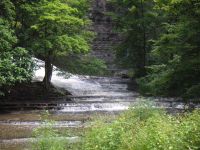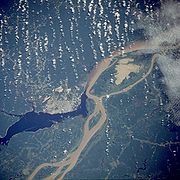.gif)
Upland and lowland (freshwater ecology)
Encyclopedia

Ecology
Ecology is the scientific study of the relations that living organisms have with respect to each other and their natural environment. Variables of interest to ecologists include the composition, distribution, amount , number, and changing states of organisms within and among ecosystems...
of freshwater
Freshwater
Fresh water is naturally occurring water on the Earth's surface in ice sheets, ice caps, glaciers, bogs, ponds, lakes, rivers and streams, and underground as groundwater in aquifers and underground streams. Fresh water is generally characterized by having low concentrations of dissolved salts and...
river
River
A river is a natural watercourse, usually freshwater, flowing towards an ocean, a lake, a sea, or another river. In a few cases, a river simply flows into the ground or dries up completely before reaching another body of water. Small rivers may also be called by several other names, including...
s, habitat
Habitat
* Habitat , a place where a species lives and grows*Human habitat, a place where humans live, work or play** Space habitat, a space station intended as a permanent settlement...
s are classified as upland and lowland.
Definitions
Upland habitats are cold, clear, rocky, fast flowing rivers in mountainous areas; lowland habitats are warm, slow flowing rivers found in relatively flat lowland areas, with water that is frequently coloured by sedimentSediment
Sediment is naturally occurring material that is broken down by processes of weathering and erosion, and is subsequently transported by the action of fluids such as wind, water, or ice, and/or by the force of gravity acting on the particle itself....
and organic matter.
These classifications overlap with the geological definitions of "upland" and "lowland". In geology
Geology
Geology is the science comprising the study of solid Earth, the rocks of which it is composed, and the processes by which it evolves. Geology gives insight into the history of the Earth, as it provides the primary evidence for plate tectonics, the evolutionary history of life, and past climates...
an "upland" is generally considered to be land that is at a higher elevation than the alluvial plain
Alluvial plain
An alluvial plain is a relatively flat landform created by the deposition of sediment over a long period of time by one or more rivers coming from highland regions, from which alluvial soil forms...
or stream terrace
Stream terrace
Fluvial terraces are elongated terraces that flank the sides of floodplains and fluvial valleys all over the world. They consist of a relatively level strip of land, called a “tread,” separated from either an adjacent floodplain, other fluvial terraces, or uplands by distinctly steeper strips of...
, which are considered to be "lowlands". The term "bottomland" refers to low-lying alluvial land near a river.
Many freshwater fish and invertebrate communities around the world show a pattern of specialisation into upland or lowland river habitats. Classifying rivers and streams as upland or lowland is important in freshwater ecology as the two types of river habitat are very different, and usually support very different populations of fish and invertebrate species.
Upland
In freshwater ecology, upland rivers and streamStream
A stream is a body of water with a current, confined within a bed and stream banks. Depending on its locale or certain characteristics, a stream may be referred to as a branch, brook, beck, burn, creek, "crick", gill , kill, lick, rill, river, syke, bayou, rivulet, streamage, wash, run or...
s are the fast flowing rivers and streams that drain elevated or mountainous country, often onto broad alluvial plain
Alluvial plain
An alluvial plain is a relatively flat landform created by the deposition of sediment over a long period of time by one or more rivers coming from highland regions, from which alluvial soil forms...
s (where they become lowland rivers). However, altitude is not the sole determinant of whether a river is upland or lowland. Arguably the most important determinants are that of stream power and course gradient. Rivers with a course that drops in altitude rapidly will have faster water flow and higher stream power or "force of water". This in turn produces the other characteristics of an upland river - an incised course, a river bed dominated by bedrock
Bedrock
In stratigraphy, bedrock is the native consolidated rock underlying the surface of a terrestrial planet, usually the Earth. Above the bedrock is usually an area of broken and weathered unconsolidated rock in the basal subsoil...
and coarse sediments, a riffle
Riffle
A Riffle is a short, relatively shallow and coarse-bedded length of stream over which the stream flows at higher velocity and higher turbulence than it normally does in comparison to a pool....
and pool structure and cooler water temperatures. Rivers with a course that drops in altitude very slowly will have slower water flow and lower force. This in turn produces the other characteristics of a lowland river - a meandering course lacking rapids, a river bed dominated by fine sediments and higher water temperatures. Lowland rivers tend to carry more suspended sediment
Sediment
Sediment is naturally occurring material that is broken down by processes of weathering and erosion, and is subsequently transported by the action of fluids such as wind, water, or ice, and/or by the force of gravity acting on the particle itself....
and organic matter as well, but some lowland rivers have periods of high water clarity in seasonal low flow periods.
The generally clear, cool, fast-flowing waters and bedrock and coarse sediment beds of upland rivers encourage fish species with limited temperature tolerances, high oxygen needs, strong swimming ability and specialised reproductive strategies to prevent eggs or larvae being swept away. These characteristics also encourage invertebrate species with limited temperature tolerances, high oxygen needs and ecologies revolving around coarse sediments and interstices or "gaps" between those coarse sediments.
Lowland

Macrophyte
A macrophyte is an aquatic plant that grows in or near water and is either emergent, submergent, or floating. In lakes macrophytes provide cover for fish and substrate for aquatic invertebrates, produce oxygen, and act as food for some fish and wildlife....
s ("water weed").
See also
- Freshwater biologyFreshwater biologyFreshwater ecosystems are a subset of Earth's aquatic ecosystems. They include lakes and ponds, rivers, streams and springs, and wetlands. They can be contrasted with marine ecosystems, which have a larger salt content...
- River reclamation
- Riparian zoneRiparian zoneA riparian zone or riparian area is the interface between land and a river or stream. Riparian is also the proper nomenclature for one of the fifteen terrestrial biomes of the earth. Plant habitats and communities along the river margins and banks are called riparian vegetation, characterized by...

